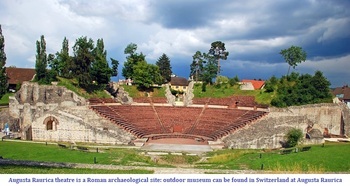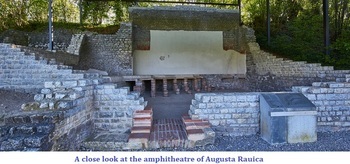

Around 44–43 BCE, Lucius Munatius Plancus (90–15 BCE) founded Augusta Raurica, which swiftly developed into a metropolis and, by the time of its brief heyday in 200 CE, had between 10,000–20,000 residents.
The majority of Augusta Raurica's people left the city despite its rapid growth in just three centuries due to ongoing Alemanni invasions,  an earthquake around 250 CE, and ongoing political upheaval in Roman Rhaetia.A well-preserved Roman-era site can be found in Switzerland close to Basel called Augusta Raurica which is situated on the south bank of the Rhine river.
an earthquake around 250 CE, and ongoing political upheaval in Roman Rhaetia.A well-preserved Roman-era site can be found in Switzerland close to Basel called Augusta Raurica which is situated on the south bank of the Rhine river.
Around 44 BC, the Romans established the colony of Augusta Raurica, giving it the name of the nearby Rauraci tribe of the Gallic people. Today it is a site of national significance.
Around 44 BC,  Lucius Munatius Plancus established Augusta Raurica in the territory of the Rauraci, a nearby Gallic tribe that was related to the Helvetii. Colonia Raurica is all that is mentioned in the gravestone inscription for Munatius Plancus.
Lucius Munatius Plancus established Augusta Raurica in the territory of the Rauraci, a nearby Gallic tribe that was related to the Helvetii. Colonia Raurica is all that is mentioned in the gravestone inscription for Munatius Plancus.
In its heyday, Augusta Raurica served as the seat of a local Roman province and was a thriving commercial trading hub by the second century AD.
Lucius Munatius Plancus established Augusta Raurica in about 44 BC. Around 15 BC, the colony's capital, Augusta Raurica, was built. With 15,000 residents, the town expanded within 200 years to become a thriving trading centre and regional metropolis.
A Celtic tribe known as the "Raurici" had lived in Augusta Raurica, according to historians. They settled close to the Rhine River and constructed a Celtic oppidum.
No archaeological evidence has been found from this period yet. At the start of Julius Caesar's Gallic Wars, this tribe made an effort to colonize regions in eastern France alongside the Helvetii and others.
When Julius Caesar defeated them in 58 BCE at the Battle of Bibracte in what is now France, they moved back east toward what is now Switzerland. It established Roman supremacy over the western and southern banks of the Rhine.
Later on, it was colonized by Augustus Caesar. The colony was called in honour of the Roman emperor, and the Romans established the city on a plateau close to Augst and the Rhine River using wood from the region's forests.
Augusta Raurica was a thriving commercial trading hub by the second century AD, and in its heyday, it served as the administrative centre for a nearby Roman province.
The city was strategically situated between the Danube River, Italy, Germany, and the Rhine River, making it the ideal place for a commerce entrepot. Also, it exports smoked pork and bacon to other roman territories.
Due to significant political and cultural sway throughout the first century over Augusta Raurica by Romans, intermarriage and the blending of Celtic and Latin culture sparked the emergence of Gallo-Roman society.
It is quite likely that some residents of Augusta Raurica were Jewish based on the discovery of a finger ring with a seven-branched candelabrum (Menorah) there. Also, it was governed under a republican type of constitution due to the impact of Romans.
As Augusta Raurica grew, it developed into a standard Roman town with facilities, common areas, and temples. However, the town suffered during the first decade of the Third Century Crisis (235-284 AD) and came under attack from raiding Alemanni tribes from the Rhine. A significant portion of the city was destroyed by a strong earthquake in 250 AD. Soon later, in or around 260 AD, Roman legions decimated the city.
The Romans understood Augusta Raurica's strategic importance despite a significant section of its population dying from disease and famine as a result of the Gallic Empire conflict (260-276 CE). They constructed a castle called Castrum Rauracense to maintain their military positions whereas Augusta Raurica was relocated in a significantly smaller fashion. Roman control over what is now Switzerland began to wane about the year 400 CE when the army withdrew from Castrum Rauracense and moved in the direction of the Italian peninsula.
The later Roman castrum and the excavated Augusta Raurica are now revered as national historic landmarks. The modest ruins of the amphitheatre, aqueduct, forum with a temple to Jupiter and basilica, as well as the remarkable remains of the theatre, at the abandoned settlement, are still viewed.
Along with portions of a sewer, a taberna, a bakery, a potter's studio, and a tile kiln have all been discovered. Excavation has not yet taken place in about 80% of the built-up area, hence making it the best-preserved city of Romans.
Augusta Raurica has been described as an important heritage site of national importance. The Roman Museum displays the history of Augusta Raurica and exhibits the most significant finds from the Roman city. Also, the Roman house has been reconstructed in the museum to showcase the daily life of earlier Romans. Hence it is one of the most well-preserved heritage sites in Switzerland.
Q1. What was the name of Switzerland in the Roman era?
Ans. In 15 BCE, Caesar Augustus added the modern-day nation of Switzerland to the Roman Empire. It takes its name from the Celtic Helvetii, which inhabited what is now western Switzerland. Confoederatio Helvetica is also where the worldwide abbreviation CH for Switzerland originates from.
Q2. How Augusta Raurica helped Roman King Augustus in the further expansion?
Ans. Augusta Raurica was a crucial component of Augusta's conquest strategy. It helped Augustus to conquer further two colonies that retain his name, Augusta Praetoria and Augusta Vindelicum. These 3 Augustae serve as the cornerstone of a triangle that spans Augustus's alpine conquests, the long base of which, from the Rhine's knee to the Danube, served as the border with unconquered Germania.
Q3. Write a short note on the theatre of Augusta Raurica.
Ans. The most well-preserved ancient theatre of its kind north of the Alps is the playhouse at Augusta Raurica. There are two phases in theatre. One is arena theatre which showcases gladiator fights, animal fights, etc and the second is stage theatre which is mainly used for stage performances and political gatherings. The second theatre was used as an amphitheatre for almost 70 years after the original theatre was demolished (110 AD – 180 AD).